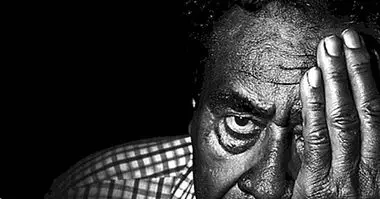Coprophobia (fear of stool): causes, symptoms and treatment
Coprophabia, also known as scaphobia, is a specific phobia whose affected manifest an irrational and unjustified fear towards excrements. The patients of this rare disorder suffer high levels of anxiety when they are facing a dregs. In this way, they try to avoid seeing or perceiving excrement whenever they can.
Although it is an uncommon malaise, those affected by coprophobia can see their daily life altered and suffer a malaise that requires psychological treatment. In this summary we will review what coprofobia consists of, its most frequent causes, its symptoms and signs and different types of intervention that can help manage it.
- Related article: "The 15 purest phobias that exist"
What is coprofobia?
The coprofobia is an alteration of the anxiety . It is a specific phobia that is unusual and that requires health and / or psychological intervention in most cases.
These subjects feel an extreme aversion towards the feces, appearing an unusual and exaggerated fear towards the excrements. This fear may be based on certain beliefs or irrational thoughts and generate great anxiety.
Characteristics and diagnosis
Not all fears or rejection of feces can be labeled with the diagnosis of coprophagous. In fact, for the diagnosis to be reliable, it will be essential that there are certain symptoms and specific characteristics. They are the following.
1. Exaggerated fear
The fear of faeces experienced by those affected by coprophagosis is clearly excessive in its intensity and in terms of the discomfort it generates. . This means that, when exposed to excrement, his mind reacts with acute symptoms of anxiety and nervousness.
The excrement does not pose a real threat to humans, but the individuals affected by coprofobia have distorted cognitions and perceive them as highly threatening or dangerous.
2. Irrational thoughts
The fear that coprofobia generates is high intensity and exaggerated because it is not based on rational thoughts. These distorted cognitions generate anxiety in the face of a false threat .
Distorted and unrealistic ideas about the potential danger of faeces are the cause of the discomfort manifested by the affected subject.
3. Uncontrollable fear
Another characteristic symptom of coprofobia is that fear is uncontrollable . That is, the affected individual has no recourse to manage the emergence of negative sensations, as well as unwanted anxiety responses.
4. Persistent fear
Fear is also characterized by being prolonged in time, that is, persistent . It is not a fear that arises in isolation or on time, at a specific stage or after a specific experience.
In this way, the phobic fear of feces may not be resolved if psychological measures are not taken and a clinical intervention is performed on the patient.
5. Avoidance
Finally, phobic fear of excrement generates the main behavior of this phobia: avoidance. The subjects with this phobia try to avoid as much as possible exposing themselves to the feces, even escaping suddenly to avoid such contact.
Symptoms Coprofobia is an anxiety disorder, since its symptoms are mainly those of an anxious patient.
The expressions that have the coprofobia in the behavior and the mind of the affected can be of three types: cognitive symptoms, physical symptoms and behavioral symptoms.
1. Physical symptoms
The fear suffered by people with coprofobia generate the emergence of a long list of alterations in the proper functioning of their body when the affected is exposed to excrement.
This alteration is caused by a mismatch of the normal activity of the autonomic nervous system. This increase can lead to a series of signs of anxiety , like the following:
- Increased heart rate
- Increased breathing rhythm
- Palpitations
- Tachycardia
- Muscle tension
- Sweating
- Feeling of unreality
- Dizziness, nausea and vomiting
2. Cognitive symptoms
In addition to the physical signals, coprofobia also produces a series of cognitive-type alterations . These are based on irrational ideas and thoughts about the discomfort and the threat posed by excrement.
These thoughts arise with greater force and intensity when the affected person is exposed to the phobic element. In addition, the physical symptoms feed back and stimulate the anxiety produced by the phobic stimulus.
3. Behavioral symptoms
By last, the coprofobia also presents several behavioral or behavioral symptoms . These manifestations arise in response to physical and cognitive symptoms, due to the increased anxiety and general malaise suffered by the affected person.
The most common behaviors in this disorder are avoidance and flight. Avoidance is defined as that series of behaviors that the patient does in order not to come into contact with excrement. On the other hand, flight is the behavior that takes place when the individual can not avoid coming into contact with feces and instinctively departs from the phobic stimulus.
Causes
The coprofobia is a phobia that can be due to different causes and factors that can be considered risk.
The propensity to suffer anxiety, vicarious conditioning, verbal conditioning, certain personality traits or genetic risk factors make a person more at risk of developing this phobic disorder.
Treatment
The best treatment for this type of phobias is psychological therapy . Specifically, cognitive-behavioral therapy has been shown to be highly effective in controlling symptoms and returning the subject to normal.
This therapy is based on the progressive exposure to the phobic stimulus. Slowly, the patient gets closer (throughout the therapy sessions) and habituates to the feces and learns to manage his anxiety and the discomfort he feels.
Bibliographic references:
- American Psychiatric Association. DSM-IV-TR Diagnostic and Statistical Manual of Mental Disorders (2002). Barcelona: Masson.
- Braunstein, N. A. (2015). Classify in psychiatry. 2a. reprint. Mexico: Siglo XXI



















